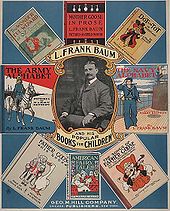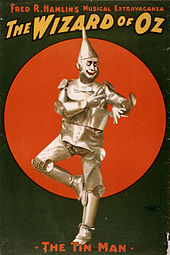The South Dakota years[edit]
In July 1888, Baum and his wife moved to Aberdeen, Dakota Territory where he opened a store called "Baum's Bazaar". His habit of giving out wares on credit led to the eventual bankrupting of the store,[14] so Baum turned to editing the local newspaper The Aberdeen Saturday Pioneer where he wrote the column Our Landlady.[15] Following the death of Sitting Bull at the hands of a federal agent, Baum urged the wholesale extermination of all America's native peoples in a column that he wrote on December 20, 1890. On January 3, 1891 he returned to the subject in an editorial response to the Wounded Knee Massacre:[16]
A recent analysis of these editorials has challenged their literal interpretation, suggesting that the actual intent of Baum was to generate sympathy for the Indians via obnoxious argument, ostensibly promoting the contrary position.[18]
Baum's description of Kansas in The Wonderful Wizard of Oz is based on his experiences in drought-ridden South Dakota. During much of this time, Matilda Joslyn Gage was living in the Baum household. While Baum was in South Dakota, he sang in a quartet which included James Kyle, who became one of the first Populist (People's Party) Senators in the U.S.[citation needed][19]
Writing[edit]
Baum's newspaper failed in 1891, and he, Maud, and their four sons moved to the Humboldt Park section of Chicago, where Baum took a job reporting for the Evening Post. Beginning in 1897, he edited a magazine for advertising agencies for several years, focused on window displays in stores. The major department stores created elaborate Christmastime fantasies, using clockwork mechanisms that made people and animals appear to move. In 1900, Baum published a book about window displays in which he stressed the importance of mannequins in drawing customers.[20] He also had to work as a traveling salesman.[21]
In 1897, he wrote and published Mother Goose in Prose, a collection of Mother Goose rhymes written as prose stories and illustrated by Maxfield Parrish. Mother Goose was a moderate success and allowed Baum to quit his door-to-door sales job (which had had a negative impact on his health). In 1899, Baum partnered with illustrator W.W. Denslow to publish Father Goose, His Book, a collection of nonsense poetry. The book was a success, becoming the best-selling children's book of the year.[22]
The Wonderful Wizard of Oz[edit]
Main article: The Wonderful Wizard of Oz
In 1900, Baum and Denslow (with whom he shared the copyright) published The Wonderful Wizard of Oz to much critical acclaim and financial success.[23] The book was the best-selling children's book for two years after its initial publication. Baum went on to write thirteen more novels based on the places and people of the Land of Oz.
The Wizard of Oz: Fred R. Hamlin's Musical Extravaganza[edit]
Two years after Wizard's publication, Baum and Denslow teamed up with composer Paul Tietjens and director Julian Mitchell to produce a musical stage version of the book under Fred R. Hamlin.[24] Baum and Tietjens had worked on a musical of The Wonderful Wizard of Oz in 1901 and based closely upon the book, but it was rejected. This stage version opened in Chicago in 1902 (the first to use the shortened title "The Wizard of Oz"), then ran on Broadway for 293 stage nights from January to October 1903. It returned to Broadway in 1904, where it played from March to May and again from November to December. It successfully toured the United States with much of the same cast, as was done in those days, until 1911, and then became available for amateur use. The stage version starred David C. Montgomery and Fred Stone as the Tin Woodman and Scarecrow respectively, which shot the pair to instant fame.
The stage version differed quite a bit from the book, and was aimed primarily at adults. Toto was replaced with Imogene the Cow, and Tryxie Tryfle (a waitress) and Pastoria (a streetcar operator) were added as fellow cyclone victims. The Wicked Witch of the West was eliminated entirely in the script, and the plot became about how the four friends were allied with the usurping Wizard and were hunted as traitors to Pastoria II, the rightful King of Oz. It is unclear how much control or influence Baum had on the script; it appears that many of the changes were written by Baum against his wishes due to contractual requirements with Hamlin. Jokes in the script, mostly written by Glen MacDonough, called for explicit references to President Theodore Roosevelt, Senator Mark Hanna, Rev. Andrew Danquer, and oil magnate John D. Rockefeller. Although use of the script was rather free-form, the line about Hanna was ordered dropped as soon as Hamlin got word of his death in 1904.
Beginning with the success of the stage version, most subsequent versions of the story, including newer editions of the novel, have been titled "The Wizard of Oz", rather than using the full, original title. In more recent years, restoring the full title has become increasingly common, particularly to distinguish the novel from the Hollywood film.
Baum wrote a new Oz book, The Marvelous Land of Oz, with a view to making it into a stage production, which was titled The Woggle-Bug, but Montgomery and Stone balked at appearing when the original was still running. The Scarecrow and Tin Woodman were then omitted from this adaptation, which was seen as a self-rip-off by critics and proved to be a major flop before it could reach Broadway. He also worked for years on a musical version of Ozma of Oz, which eventually became The Tik-Tok Man Of Oz. This did fairly well in Los Angeles, but not well enough to convince producer Oliver Morosco to mount a production in New York. He also began a stage version of The Patchwork Girl of Oz, but this was ultimately realized as a film.



No comments:
Post a Comment